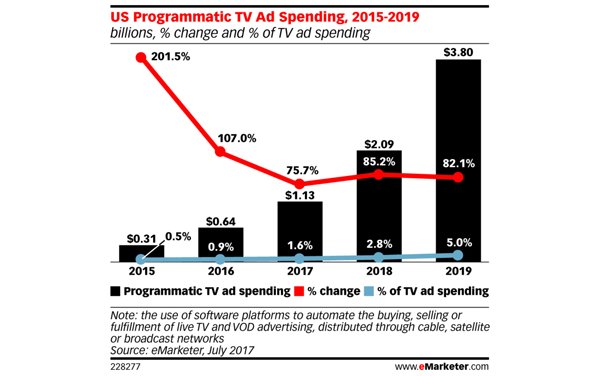
Ad spending for addressable TV and
programmatic TV (PTV) is expected to grow in the U.S. by double digits through 2019, according to an eMarketer forecast.
The digital researcher projects that in 2017, addressable TV ad
spending will grow 65.8% to reach $1.26 billion. It defines addressable TV ads as targeted ads delivered by a cable or satellite provider, via internet-connected set-top boxes. The ads mainly
target viewers based on age and gender and can be seen during live broadcast/cable viewing or during on-demand viewing.
While three-quarters of U.S. households have cable or satellite boxes
capable of delivering targeted ads, addressable TV spending will make up just 1.7% of total TV ad expenditures ($72.72 billion) in the U.S. this year, according to eMarketer. By 2019, that proportion
will grow to 4.0%.
“Addressable TV is a seller’s market. Even though cable and satellite providers have the capability to target 74 million U.S. households, they are
rationing the inventory,” stated eMarketer forecasting analyst Oscar Orozco. “Some targeted TV ads command lower prices, and measurement capability is limited at this
point.”
Meanwhile, ad spending on PTV will grow 75.7% to $1.13 billion this year, representing 1.6% of total TV ad spending in the U.S., according to eMarketer. It said that in
2018, PTV spend will grow another 85.2% to $2.09 billion, and will reach nearly $4 billion by 2019.
While the advanced targeting aspect of programmatic TV ad spending is rather sophisticated,
“pure automation from beginning to end is still not as advanced as it is for digital programmatic. Currently, ad placement is still generally done manually. For programmatic TV ad
spend to grow as fast as we’ve seen on the digital side, it must advance to complete automation,” Orozco stated.
